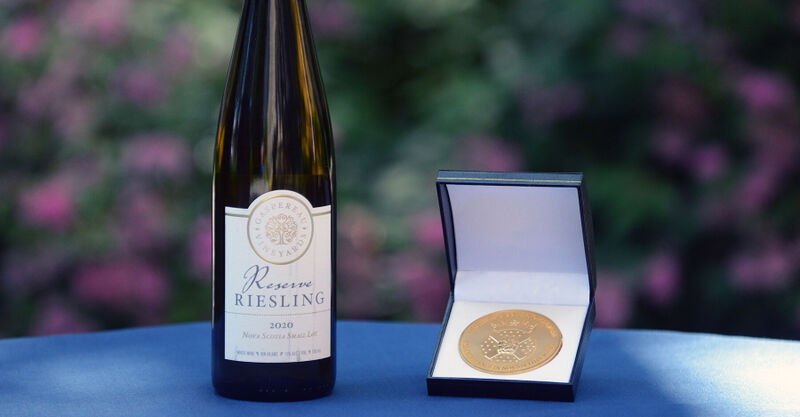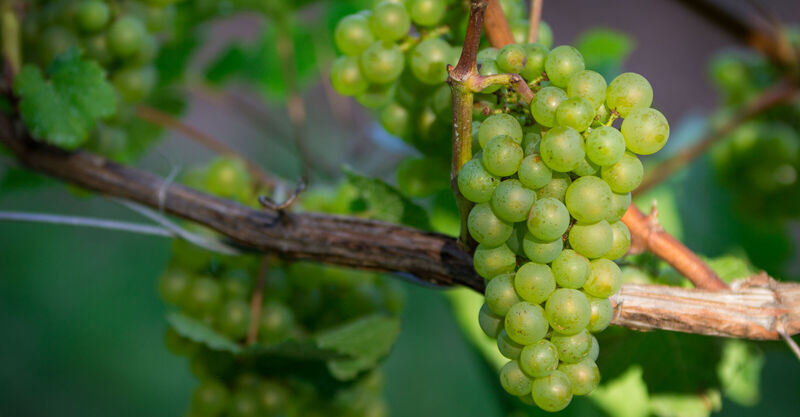Nova Scotia Varietals & Hybrids
Working and experimenting with over 50 different grape varieties which reflect the complex genetic panorama of Viticulture with its European and American vine origins; we work towards understanding the influence that our Maritime growing conditions create, matching of grape variety with climate, growing and ripening cycle and appropriate wine style.
The world of grapes are collectively defined by the botanical family Vitaceae - this family is then divided further into a Sub Genus Euvites and then still further into sub species. Amongst these sub species we find the many Vitis Vinifera which predominate the world of wine as well as other species which may be genetically crossed with Vitis Vinfera or physically joined as in the process of grafting.
Nova Scotia finds itself at the crossroads of a fascinating evolution in grapevine genetics and its effect on the ability of the vine to produce grapes of a myriad of subtleties in aroma and flavor as well as huge diversity in ability to adapt to climate and disease pressure. As genetic research becomes more advanced it has uncovered that what we think of as pure varieties – Chardonnay, Cabernet Sauvignon etc. are nothing more than genetic crosses of many other Vinifera varieties. Alongside these varieties we also have genetic crosses which are made up of Native American species with Vitis Vinifera.
Currently experimentation in Nova Scotia is advancing on two fronts. One is the growing of varieties which are ubiquitous to the established countries of Europe and the New World and on the other hand newer varieties which combine the hybrid vigor of resistance of the American varieties to cold and disease pressure such as Baco Noir, Marechal Foch, Seyval and L’Acadie.
As learning from this winemaking journey continues, the 50 varieties are paring down to those that consistently produce the finer wines which reflect our passion and aspirations.
Varietals
There are many thousands of grape varietals. Just like apples, they each have their own characteristics and best applications.
- Grape varietals belong to different species.
- Vitis vinifera – European grape species (Chardonnay, Merlot, Riesling, Sauvignon Blanc, etc.)
- Vitis labrusca, vitis riparia, vitis rotundifolia, vitis rupestris, and many others – non European.
- Varietals can be crossed….species can be interbred. Occurs by design through influence of man. Occurs naturally in vineyards. E.g. Pinot Noir – grigio (gris) blanc, meunier, etc. Some are prone to cloning in vineyard, e.g. sangiovese (Chianti) vs. Brunello.
- Some varietals adapt to a wide range of different growing areas in the world.
- Some do not.
Hybrids
These grape varietals are a cross between Vitis vinifera and North American species (labrusca, et al.)
- Many developed as early as over 100 years ago in Europe as a means to combat the scourge of European vineyards (phylloxera)
- Proved to be disease resistant.
- Europeans refrained from widespread replacement of traditional vinifera grapes.
- Less appealing after the practice of grafting rootstock took hold.
- Europeans able to keep their varietals (Cabernet Sauvignon, Chardonnay, Merlot, etc.) and solve the phylloxera problem when able to graft their vinifera vines onto North American rootstock, which offered immunity against the louse.
- Hybrids were planted and used in blends. Many plantings at one time in Burgundy. Less so today.
- Hybrids were discovered to ripen early, which was key to success in short growing seasons.
- Many introduced to Canada in 1940’s by Adhemar de Chaunac, a French wine consultant employed by Bright’s in Niagara after prohibition. Changed the landscape of wine making in Canada. He was later honoured when a varietal known as Seibel 9549 was re-named de Chaunac.
- Others developed later in North America … L’Acadie in Niagara, NY Muscat & Cayuga in NY State, Marquette in Minnesota, etc.
- Hybrids are widely used in NS for their various qualities suitable for this climate. Examples: NY Muscat, commonly labeled as simply Muscat, Leon Millot, Lucie Kuhlmann, Baco Noir, Seyval Blanc, Marechal Foch, Marquette, Cayuga, L’Acadie & Vidal Blanc to name a few.
As a general rule, Nova Scotia has developed a reputation for making cool climate styles of wine with a terroir that encourages wines of higher acidity, aromatics, and in the case of reds – approachable tannins. The result – wines that are flexible with a wide variety of food.
- Wines with good acidity = wines that make you salivate & prime your palate for food!
- Reds that are not highly tannic = reds that have a broader range of food compatibility (cross-over to weightier fish and gamebird…salmon, tuna, duck, etc.)
- Wines that are off-dry = wines that can support spicy foods (Thai, curry, wasabi with sushi, steamed mussels with garlic & peppercorns, etc.)
WHITES
L'Acadie Blanc
- Developed in Niagara, ON in 1953.
- Named L’Acadie in mid-seventies when brought to Nova Scotia. Prior to this was known as V-53621.
- Not successful in Ontario; had problems with growing season there. Challenged with losing acidity quickly after ripening.
- Flourished in NS. All wineries have found success with it.
- Very cold hardy, able to withstand temperatures of minus 22 celsius for a stretch.
- Loose bunches of grapes gives it some protection against rot.
- Produces wines very similar to cool climate chardonnays (e.g. Chablis) with common aromas associated with orchard fruit along the lines of apple & pear.
- Is versatile with winemaking techniques producing different types of wine. Can be used for production of sparkling wines, can be unoaked or oaked accordingly.
- Tend to produce wines with more body than other Canadian white wine varietals.
- Used as single varietal wine or as a blend with other varietals.
- Other than NS, there are small plantings in Ontario & Quebec, but these are not widely commercial.
Seyval Blanc
- Grown in Eastern US, England, & Eastern Canada.
- White varietal developed in Europe but used to greater success in North America.
- Known for a characteristic citrus quality with concentrated citrus aromas.
- Earlier ripening and fairly disease resistant.
- Banned for use in European wines as it has non-vinifera parentage…bone of contention between England & EU as it is grown successfully there.
- Can be subject to a myriad of wine styles and use in blends as well as single varietal bottling.
- It has a minerality some suggest is similar to white burgundy.
- Can be oaked and often is…as well as use with malolactic fermentation.
Ortega
- Developed in Bavaria in 1970’s.
- Does very well in coo climate of Germany as well as the similar climate of NS.
- Shown to be aromatic and crisp with ripe peach on the nose as well as floral notes reminiscent of Muscat.
- Primarily used for white blends but also used for icewine production.
- Tends to have lower acidity than Vidal (other icewine grape).
Muscat
- New York Muscat, member of the Muscat family of grapes which are considered the oldest grape varietal on the planet, originating near the Caucasus Mountains in Western Asia.
- This particular Muscat developed in NY state, does very well there as well as in Eastern Canada.
- Very aromatic, perfumed grape with typical aromas of grapefruit & exotic lychee fruit.
- Generally used to produce a dry style white on the palate. Has a very quick finish.
- Larger grapes with fewer per bunch on the vine, seeds are larger and bitter.
- NY Muscat is a purple skinned grape, not green like the previous two.
- Used as single varietal as well as blends (see Tidal Bay, below).
Petite Milo
- Pink coloured grape well suited to maritime climates such as NS.
- Developed recently in Switzerland by Vladimir Blattner.
- Based on a complex cross of cabernet sauvignon with the American species riparia & the Asian species amurensis.
- There are no labrusca grapes in its parentage thus avoiding a “foxy” character.
- The grapes are early ripening and disease resistant.
- This varietal can achieve high sugar levels while retaining good acidity.
- Wines produced can attain similar character to Alsatian style wines.
- The grapes and clusters on the vine are small and concentrated.
- Tropical fruit aromas can develop with wines from this varietal.
Riesling
- Originated in the Rhine region of Germany.
- Does very well in the cool climate of Germany as well as the similar climate of NS.
- An aromatic grape variety displaying flowery, almost perfumed, aromas as well as high acidity.
- Typically used for single varietal wines and for icewine.
- Used to make dry, semi-sweet, sweet, and sparkling white wines
- The fruit is highly “terroir-expressive”, meaning that the character of Riesling wines is greatly influenced by the wine’s place of origin. Nova Scotia’s warm summer days, cool nights and glacial soils contribute to the interesting expressions that are showing in Riesling wines made here.
REDS
Leon Millot
- Developed in Alsace, France approx. 100 years ago.
- Very winter hardy & disease resistant.
- Produces red wines of structure and takes very well to oak aging.
- Aromas of dark berries are predominant. Though not as tannic as Cabernet Sauvignon, this varietal produces wine of greater tannin than most other red hybrids in NS.
- The name of the varietal comes from a grape grower in Alsace.
- Used as single varietal as well as in blends.
Lucie Kuhlmann
- Performs very well in NS climate. Hardy and early ripening red varietal.
- Wines tend to be lower in tannin than others but colour from skins is very dark and concentrated.
- Produces wines with aromas of dark berries along with some smokiness on the nose.
- Developed by the same gentleman that developed Leon Millot & Marechal Foch.
Marechal Foch
- Named after the French general of world war one, this red varietal is cold hardy and disease resistant.
- Common in eastern Canada & Midwestern US.
- Wines resemble that of Burgundy or Beaujolais styles.
- Produces wine of dark colour. Marechal Foch is among a class of grapes known as teinteurier in which, unlike most grapes, these have dark colour in flesh as well as skins.
- Can produce wines using carbonic maceration for fruitier styles, as well as oak aging.
- Was once widely planted in Loire Valley, France.
- Nova Scotia’s most widely planted red varietal.
Marquette
- Introduced in 2006 after development at University of Minnesota.
- Thrives in cool climate and short growing season.
- Descended from Pinot Noir and has similar qualities but shows pronounced tannins and colour.
- Wines produced show notes of black pepper, cherry and spice.
- Grapes are of high sugar and moderate acidity.
Baco Noir
- Developed in France in 1894 by crossing a vitus riparia grape with the well-known French varietal folle blanche (typically used in cognac production)
- Brought to Canada in 1955. Was widely planted in Niagara but less so today.
- Grown in NS and used successfully for blended reds as well as single varietal wines.
- Can withstand cold winters.
- Very deeply pigmented black grapes.
- Wines produced are medium bodied and can take to oak & be very long lived with high quality.
- The grapes show high acid and vines have high vigor.
- Wines show aromas of red fruit, wildflowers, cedar & toast, blueberry & plum.



